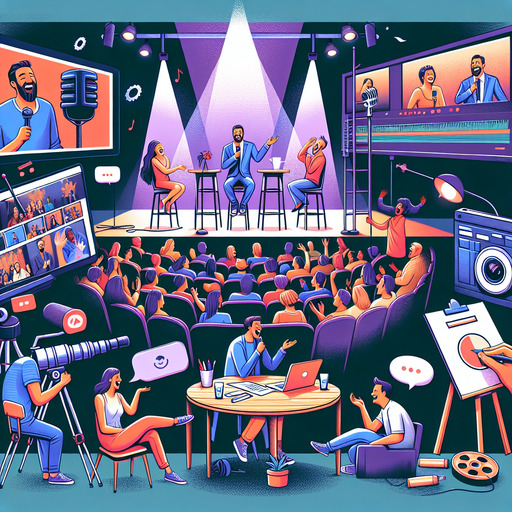
-
Table of Contents
Discover the magic of comedy creation! Watch our exclusive behind-the-scenes video on stand-up comedy production. Click here to dive in!
Introduction
Stand-up comedy, a beloved form of entertainment, often appears effortless to audiences, but the production of a stand-up comedy video involves a meticulous process. From concept to final edit, each step requires detailed planning to ensure the comedian’s performance is captured perfectly. This behind-the-scenes guide delves into every stage of the production journey—from pre-production planning to venue selection, technical setup, live recording, and post-production editing. Understanding these aspects offers insight into the artistry and expertise required to create an engaging and polished stand-up comedy video.
The Art Of Filming Stand-Up Comedy: Tips For Capturing Funny Stand-Up Clips
Filming stand-up comedy is an art that requires balancing technical precision and creative vision. The goal is to convey the live energy of a comedy show in digital form. High-quality cameras and microphones are essential to capturing the comedian’s facial expressions and voice clearly. Additionally, using multiple cameras to capture wide shots, close-ups, and audience reactions helps create dynamic edits.
Venue layout plays a significant role as well—proper camera positioning and lighting are critical for avoiding distractions like harsh shadows. Flexibility during filming is key since stand-up comedy involves spontaneous interactions and improvisation. Effective communication among the crew, facilitated by wireless systems, ensures important moments aren’t missed.
In the editing process, timing and rhythm are everything. Editors must ensure the final product maintains the pacing of the live performance while selecting the best takes and syncing audio with video. Subtitles can be added to enhance accessibility and ensure the humor isn’t lost.
Clear sound design is essential for comedy, as audio clarity is crucial for joke delivery. A balance of capturing the comedian’s voice and audience laughter, while minimizing distracting ambient noise, creates a more immersive viewing experience.
To reach a broad audience, distributing the final video on platforms like YouTube or Vimeo is key. Understanding platform algorithms, optimizing titles, and creating engaging thumbnails can help increase visibility and viewership.
Editing Stand-Up Comedy Videos: Techniques To Make Your Comedy Special Go Viral
Editing a stand-up comedy video is about more than cutting clips together—it’s about enhancing comedic timing and making the video resonate with viewers. Selecting the best takes, synchronizing audio and video, and maintaining seamless transitions are essential steps in creating a polished final product.
The editor must prioritize clear, high-quality sound, using software to clean up background noise and sharpen the comedian’s voice. Transitions between jokes should be smooth, keeping the pace of the show intact. Color grading can also help create a visual aesthetic that complements the comedian’s style, enhancing the overall viewer experience.
Incorporating audience reactions is vital to capturing the energy of the live performance. Strategically placed shots of the audience laughing or reacting help connect the home viewer to the live audience’s experience. Finally, adding graphics or subtitles enhances accessibility and keeps the video engaging.
Mastering these editing techniques ensures the final video captures the essence of the performance and has the potential to go viral, reaching a broader audience through social media and streaming platforms.
Behind The Scenes Of Stand-Up Comedy Video Production: From Recording To YouTube
The process of producing a stand-up comedy video involves much more than filming the comedian on stage. Selecting the right venue is crucial—the venue’s ambiance can impact the overall feel of the video. Comedy clubs with intimate settings often provide the best results, allowing the performer to interact closely with the audience.
Setting up high-quality cameras and microphones is the next step. Using multiple cameras from various angles (close-ups, wide shots, and audience views) allows for dynamic editing, while professional microphones ensure clear sound. Capturing the performance requires the production team to anticipate key moments and manage lighting carefully to highlight the comedian without overshadowing the scene.
After filming, the footage enters post-production, where it’s edited to maintain the comedian’s timing and energy. The editing process also includes color correction, sound mixing, and pacing to create a seamless video. Once the final product is ready, it is reviewed by the production team and comedian before uploading.
Uploading to platforms like YouTube requires more than simply posting the video. Optimizing the title, description, tags, and creating an engaging thumbnail are all crucial steps to ensure maximum reach. Promoting the video through social media also helps increase its visibility.
Q&A
- What is a common process for selecting a venue for a stand-up comedy video production?
Producers typically look for venues with good acoustics, appropriate lighting, and a layout that accommodates both the audience and camera equipment. - How do comedians prepare for a stand-up comedy video shoot?
Comedians rehearse their sets multiple times, refine material based on audience feedback, and work with directors to understand camera angles and stage movements. - What role does the production crew play during a stand-up comedy video shoot?
The crew sets up and operates cameras, manages sound equipment, coordinates lighting, and ensures that the recording runs smoothly without technical issues.